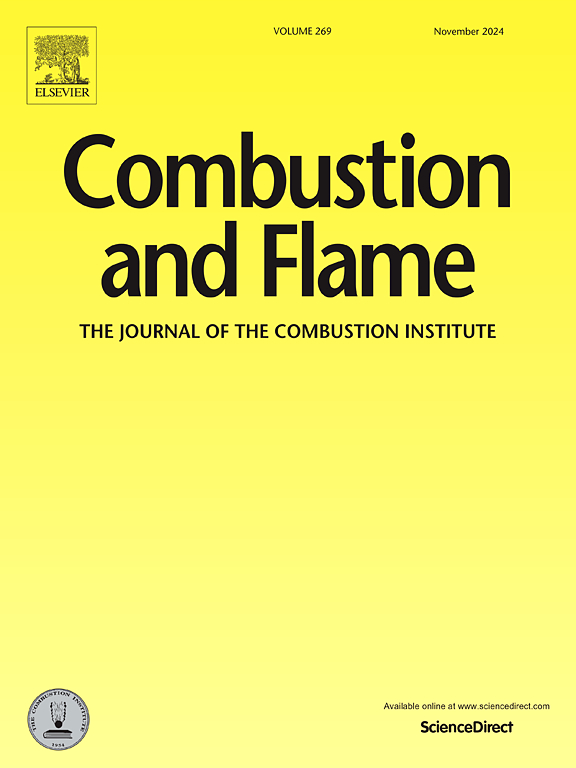Two dimensional flame structure of oscillating burner-stabilized methane-air flames
IF 5.8
2区 工程技术
Q2 ENERGY & FUELS
引用次数: 0
Abstract
The highly transient relaxational diffusive-thermal oscillations of flat burner-stabilized flames can be very attractive to probe the performance of detailed reaction mechanisms in the regimes close to ignition/extinction. In such regimes, certain reaction zones can travel over distances of the order of 10 mm and this raises an important question if one dimensional numerical models can be accurate in describing them. The question of quantitative comparison of modeling and experiments becomes crucial to study, to understand these regimes and to utilize them for validation. In this work, we experimentally investigate relaxational oscillations of methane-air flames on a flat porous burner with a surrounding nitrogen co-flow and perform fully resolved 2D numerical simulations of the same burner configuration, using a detailed reaction mechanism and molecular diffusion model, buoyancy and radiation, alongside corresponding experiments. The focus is on the effect of the nitrogen co-flow on the flame oscillations, which can only be studied numerically in 2D simulations due to the mutual effect of the complex flow field and flame dynamics. The results of both numerical and experimental approaches are found to be in quantitative agreement. They show that there is an optimal co-flow velocity that removes the secondary diffusion flame and extinguishes the edge flame settled in the stagnation flow region. This optimal regime makes the flame flatter and closer to a one-dimensional configuration and this is a most favorable condition for validation of kinetic mechanisms. The detailed data from the simulations will guide the design of the next generation of the burner configurations to study the kinetics and dynamics of complex fuels required for a sustainable energy transition.
Novelty and Significance Statement
The novelty of this research lies in the synergy of these modeling, computations with experimental measurements, allowing both parametric studies of the oscillation regime and deeper insights into the flame structure. These results are significant because they allow to develop more accurate burner configurations for studying flames near extinction and ignition conditions, which will be an important task for more complex fuels from renewable sources required for a sustainable energy transition. Ultimately, our understanding of the interplay between chemistry and diffusion controlled combustion regimes under transient conditions can be approved and validation data for e.g. chemical reaction mechanisms can be generated. The latter becomes extremely important since efficiency and pollutant mitigation issues require lean and chemistry controlled combustion processes used in the combustion facilities. Thus understanding, optimization and control of such regimes has become a crucial point for further development of the sustainable combustion.
摆动燃烧器稳定甲烷-空气火焰的二维火焰结构
扁平燃烧器稳定火焰的高度瞬态弛豫扩散热振荡对于探索接近点火/熄灭区域的详细反应机制的性能非常有吸引力。在这种情况下,某些反应区可以跨越10毫米的距离,这就提出了一个重要的问题,即一维数值模型是否能够准确地描述它们。模型和实验的定量比较问题对于研究、理解这些机制并利用它们进行验证至关重要。在这项工作中,我们实验研究了甲烷-空气火焰在一个周围有氮气共流的扁平多孔燃烧器上的弛豫振荡,并使用详细的反应机理和分子扩散模型、浮力和辐射,以及相应的实验,对相同的燃烧器配置进行了完全解析的二维数值模拟。重点是氮气共流对火焰振荡的影响,由于复杂的流场和火焰动力学的相互影响,只能在二维模拟中进行数值研究。数值方法和实验方法的结果在定量上是一致的。结果表明,存在一个最优共流速度,可以消除二次扩散火焰,并使停留在滞流区的边缘火焰熄灭。这种最优状态使火焰更平坦,更接近一维构型,这是验证动力学机制的最有利条件。模拟的详细数据将指导下一代燃烧器配置的设计,以研究可持续能源转换所需的复杂燃料的动力学和动力学。新颖性和意义声明本研究的新颖性在于这些建模,计算与实验测量的协同作用,允许振荡制度的参数化研究和更深入地了解火焰结构。这些结果意义重大,因为它们允许开发更精确的燃烧器配置,用于研究接近熄灭和点火条件的火焰,这将是可持续能源转型所需的更复杂的可再生燃料的重要任务。最终,我们对瞬态条件下化学和扩散控制燃烧机制之间相互作用的理解可以得到批准,并且可以生成化学反应机制等验证数据。后者变得极其重要,因为效率和污染物减排问题需要在燃烧设施中使用精益和化学控制的燃烧过程。因此,了解、优化和控制这种状态已成为进一步发展可持续燃烧的关键。
本文章由计算机程序翻译,如有差异,请以英文原文为准。
求助全文
约1分钟内获得全文
求助全文
来源期刊

Combustion and Flame
工程技术-工程:化工
CiteScore
9.50
自引率
20.50%
发文量
631
审稿时长
3.8 months
期刊介绍:
The mission of the journal is to publish high quality work from experimental, theoretical, and computational investigations on the fundamentals of combustion phenomena and closely allied matters. While submissions in all pertinent areas are welcomed, past and recent focus of the journal has been on:
Development and validation of reaction kinetics, reduction of reaction mechanisms and modeling of combustion systems, including:
Conventional, alternative and surrogate fuels;
Pollutants;
Particulate and aerosol formation and abatement;
Heterogeneous processes.
Experimental, theoretical, and computational studies of laminar and turbulent combustion phenomena, including:
Premixed and non-premixed flames;
Ignition and extinction phenomena;
Flame propagation;
Flame structure;
Instabilities and swirl;
Flame spread;
Multi-phase reactants.
Advances in diagnostic and computational methods in combustion, including:
Measurement and simulation of scalar and vector properties;
Novel techniques;
State-of-the art applications.
Fundamental investigations of combustion technologies and systems, including:
Internal combustion engines;
Gas turbines;
Small- and large-scale stationary combustion and power generation;
Catalytic combustion;
Combustion synthesis;
Combustion under extreme conditions;
New concepts.
 求助内容:
求助内容: 应助结果提醒方式:
应助结果提醒方式:


